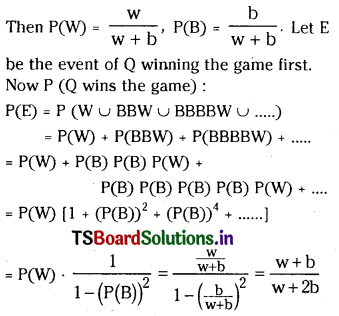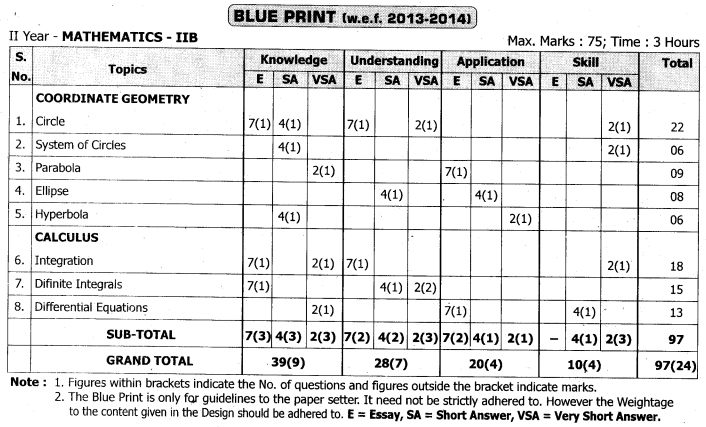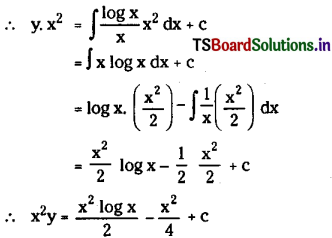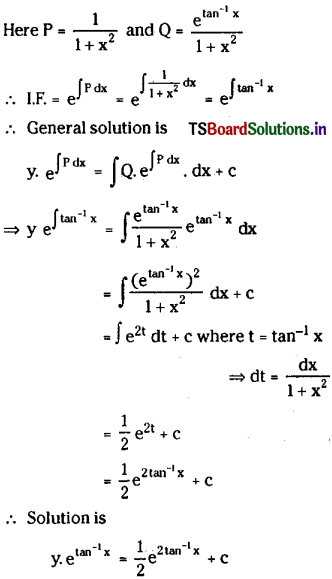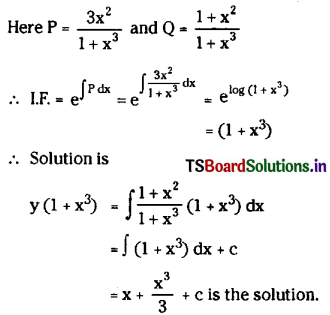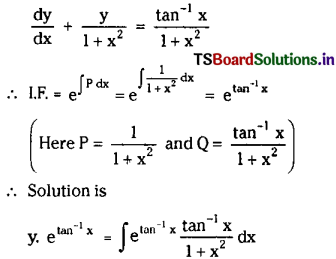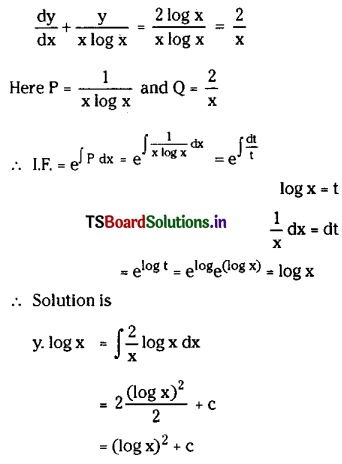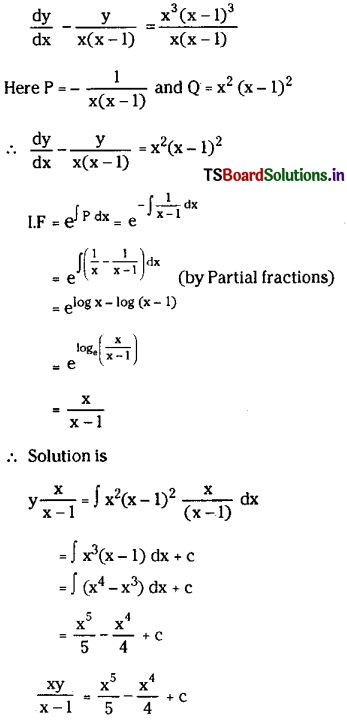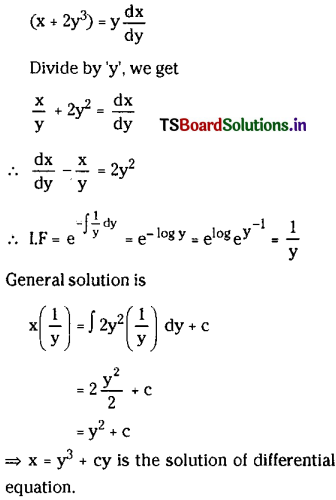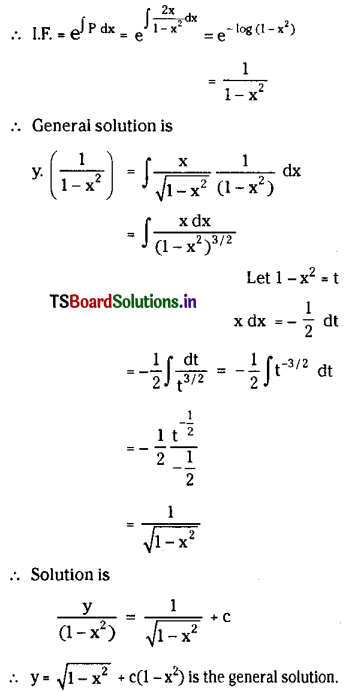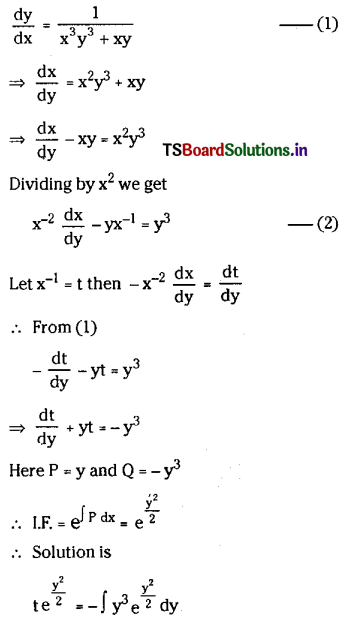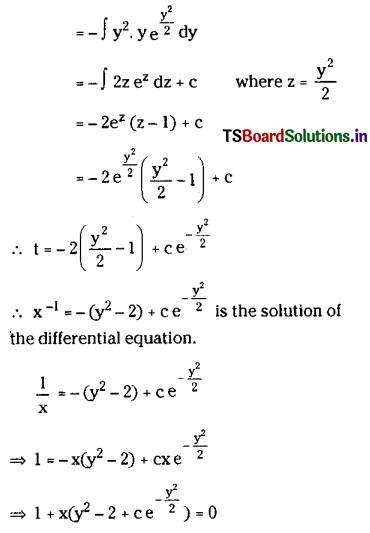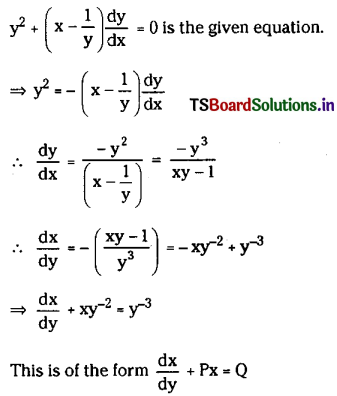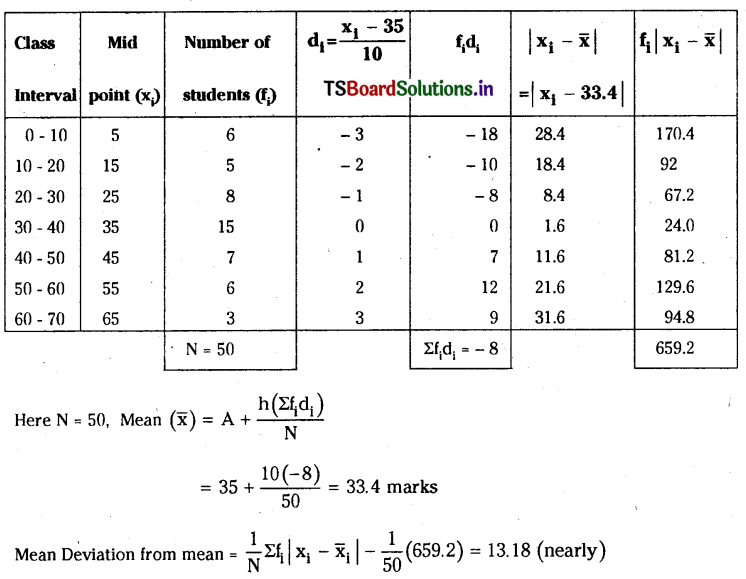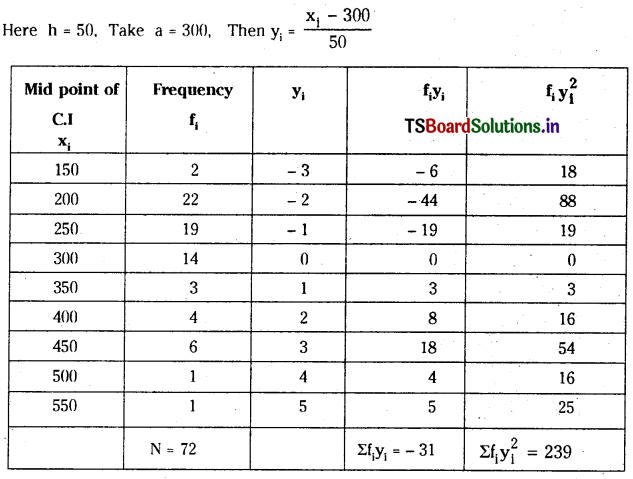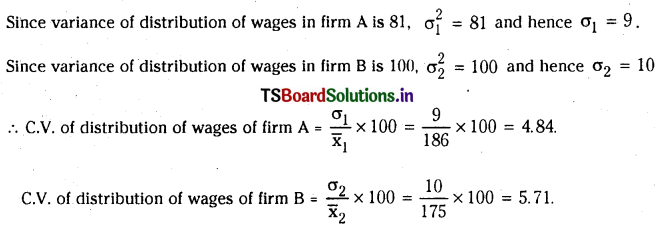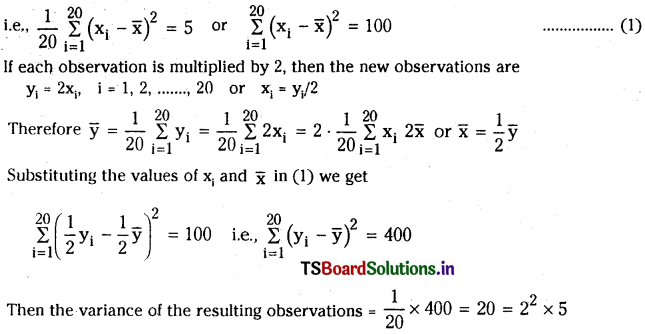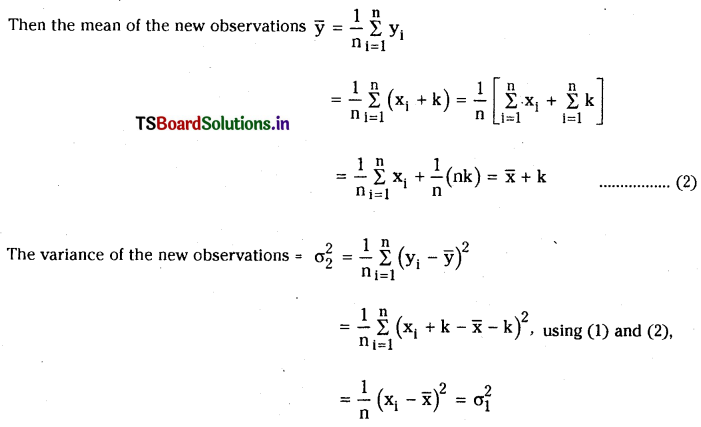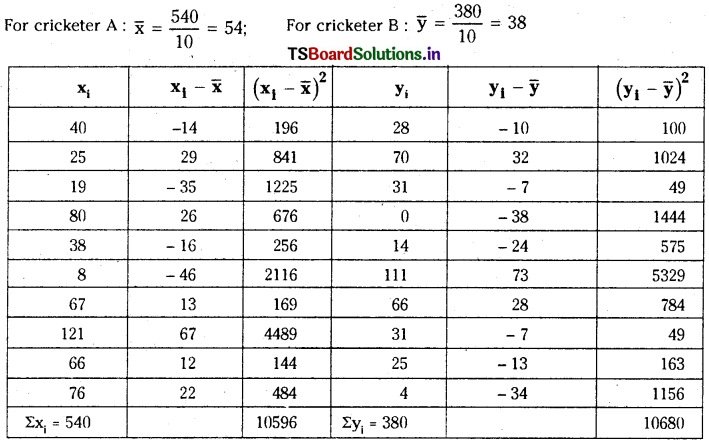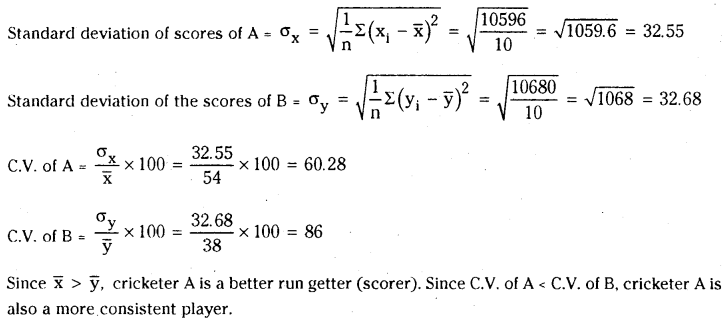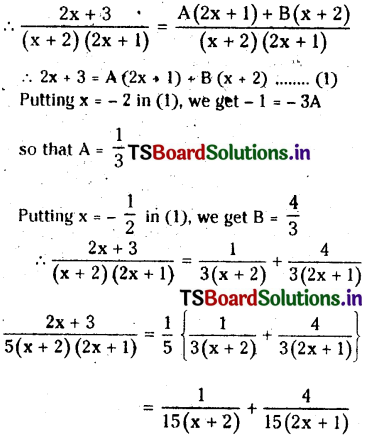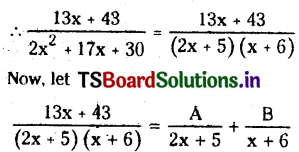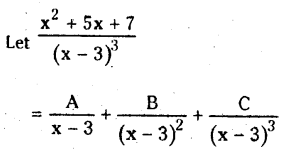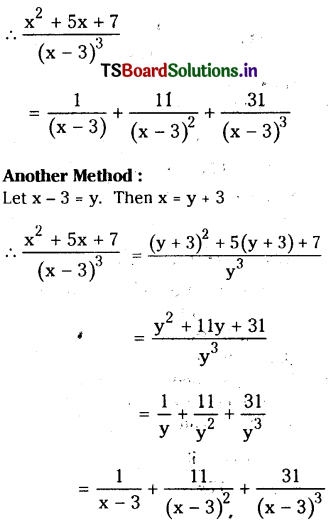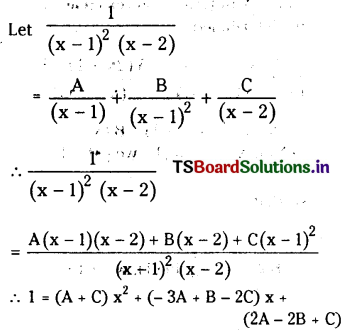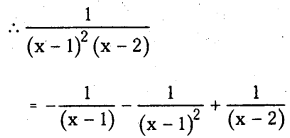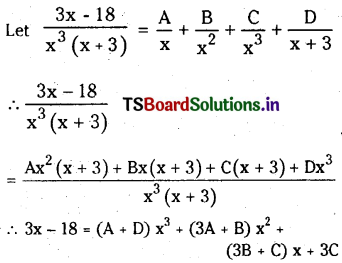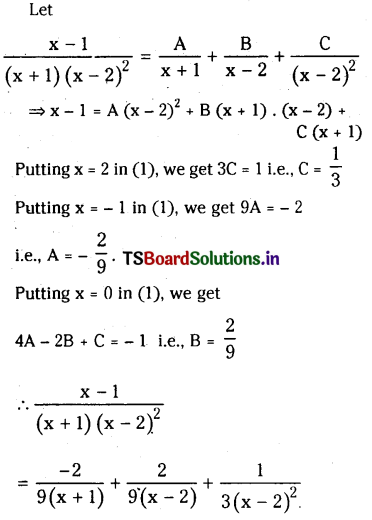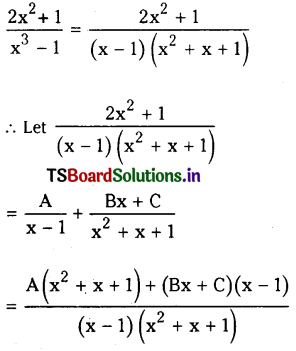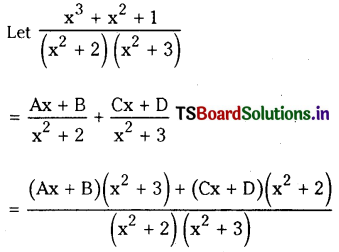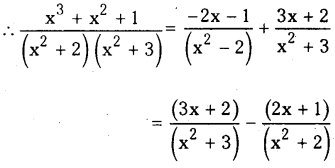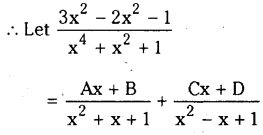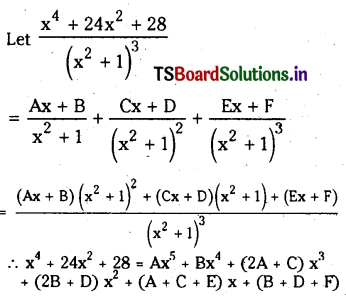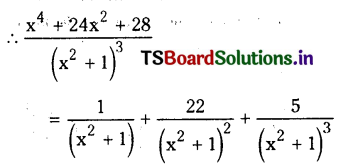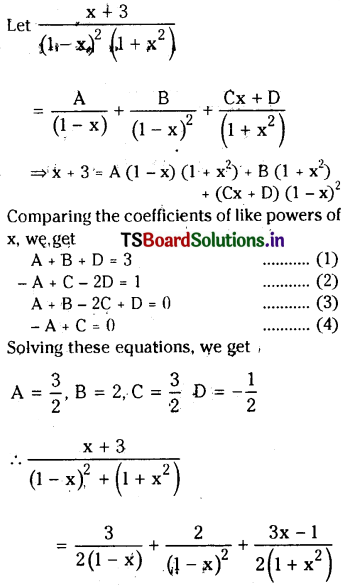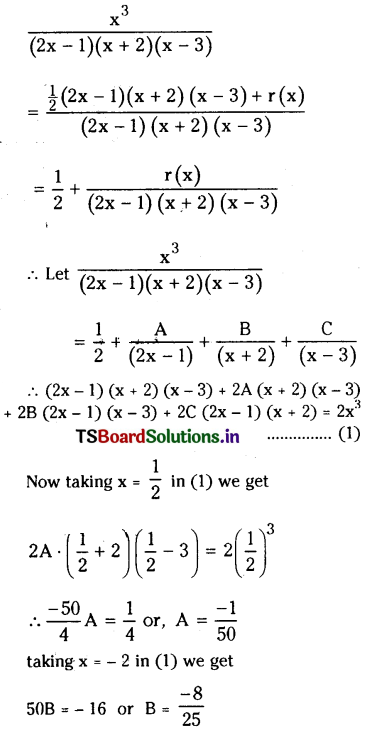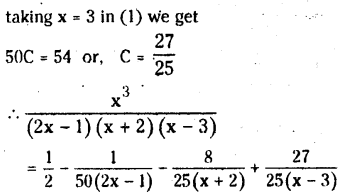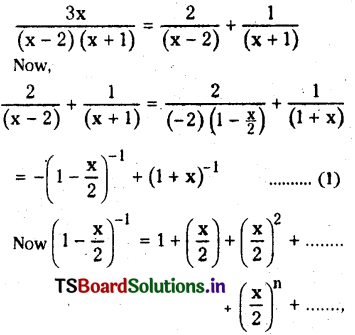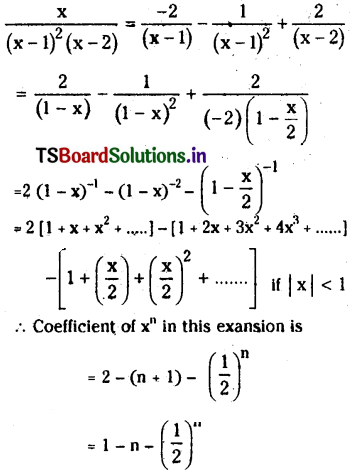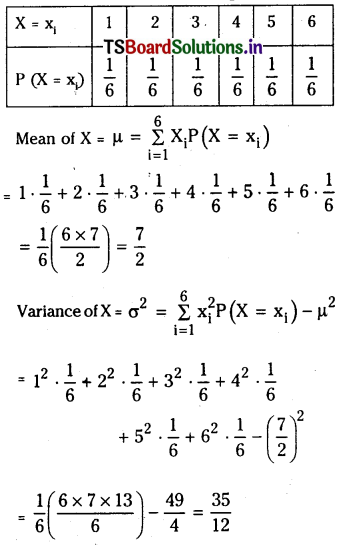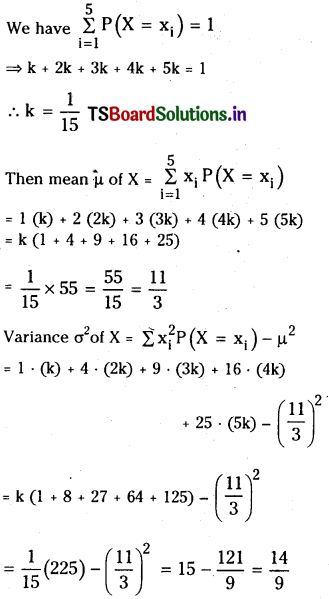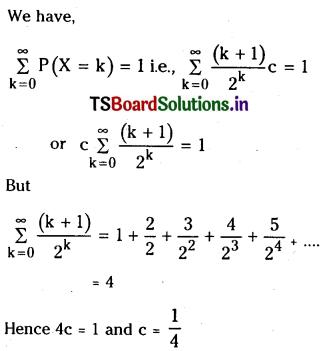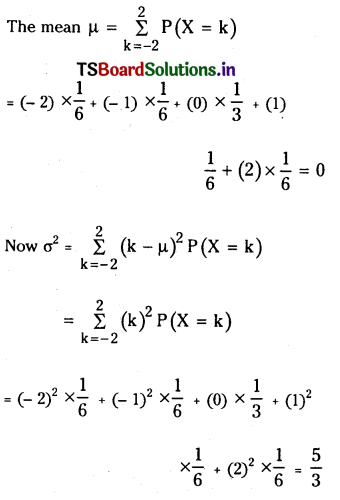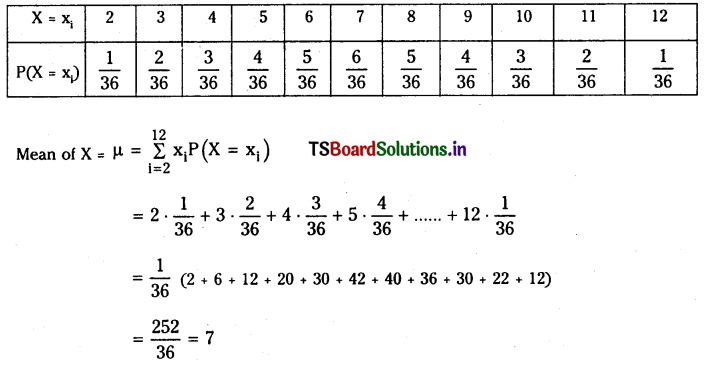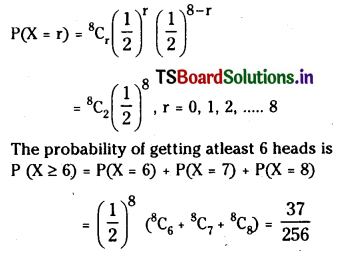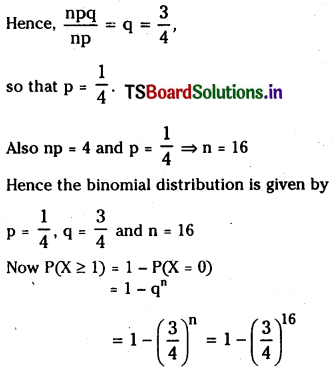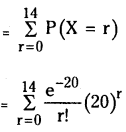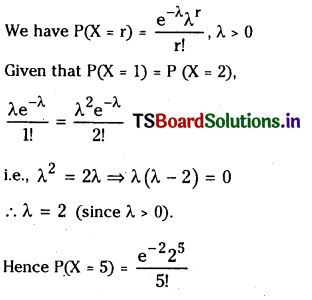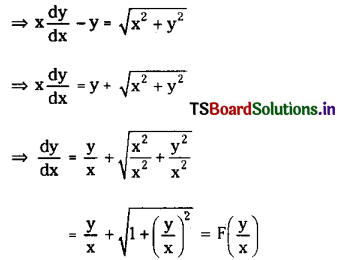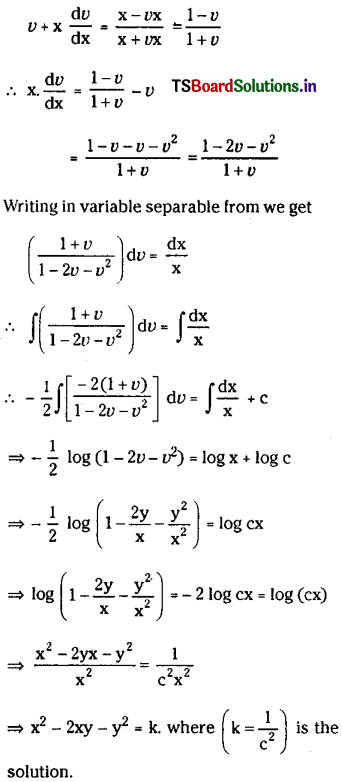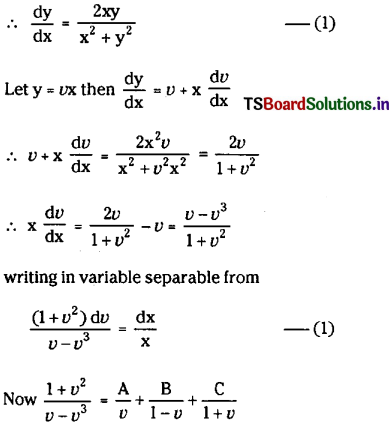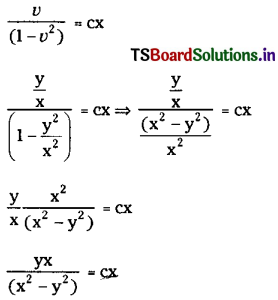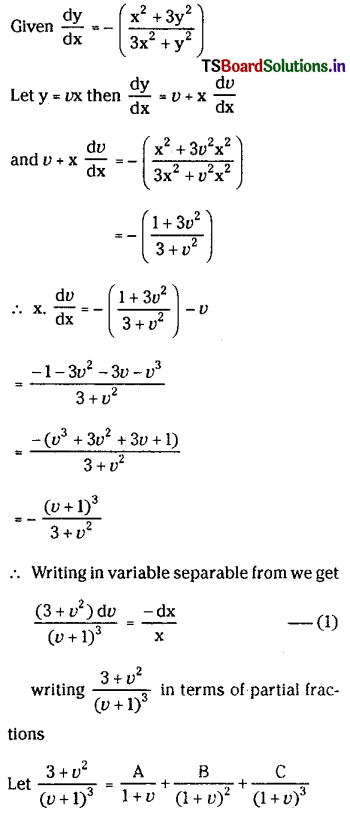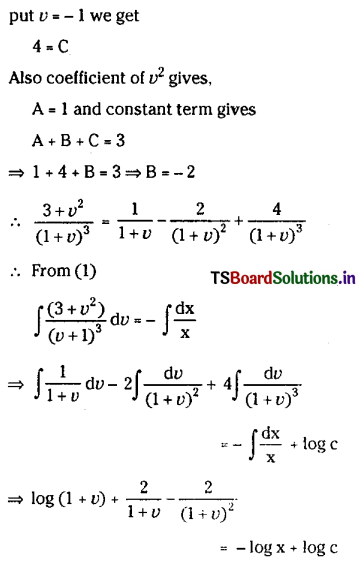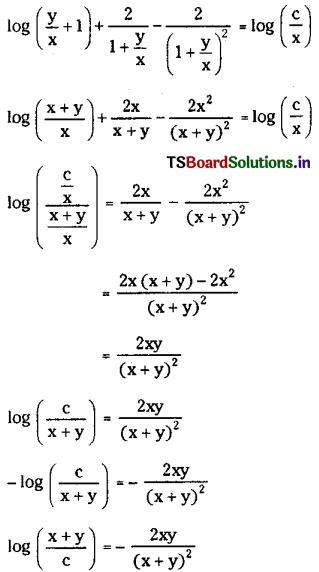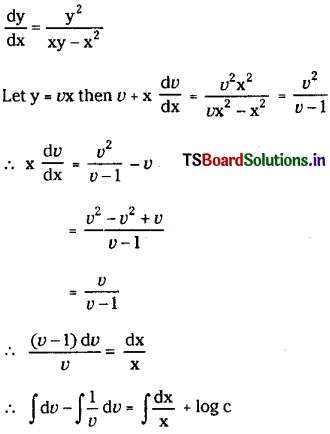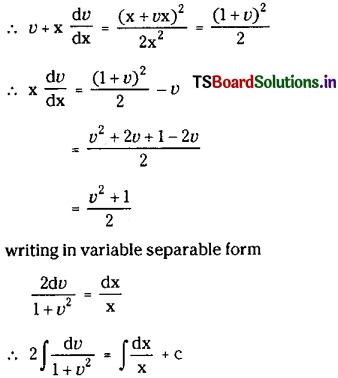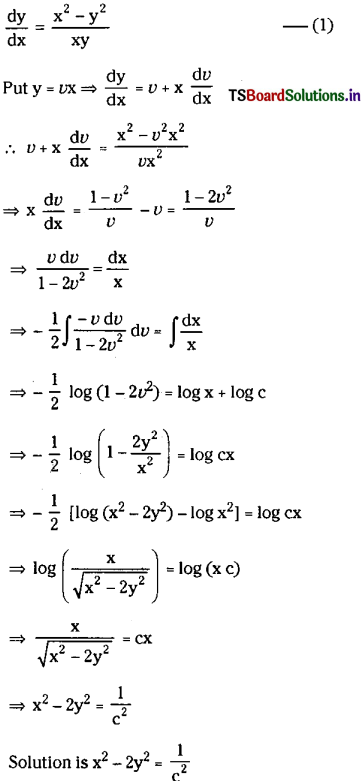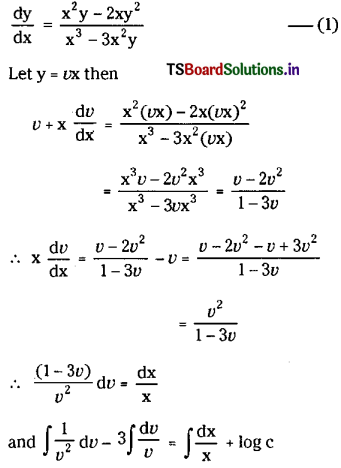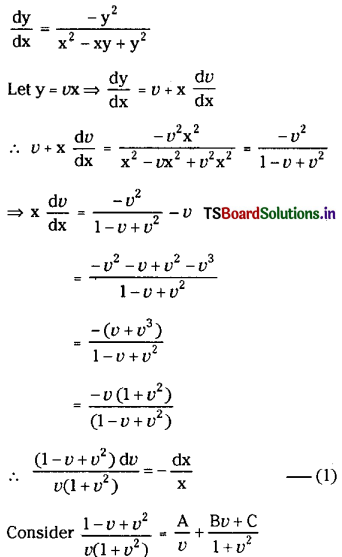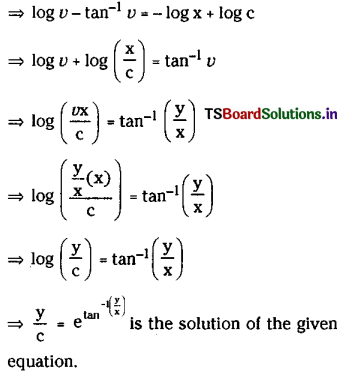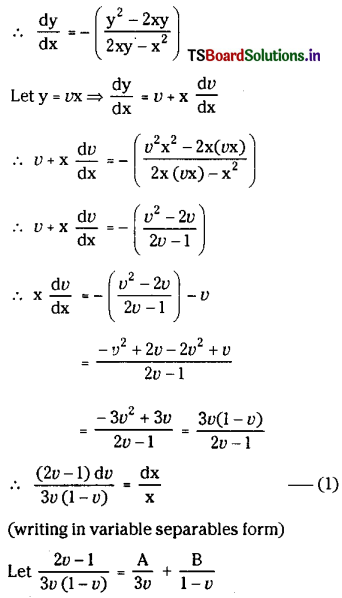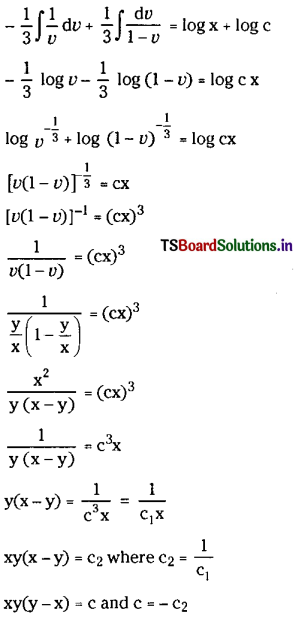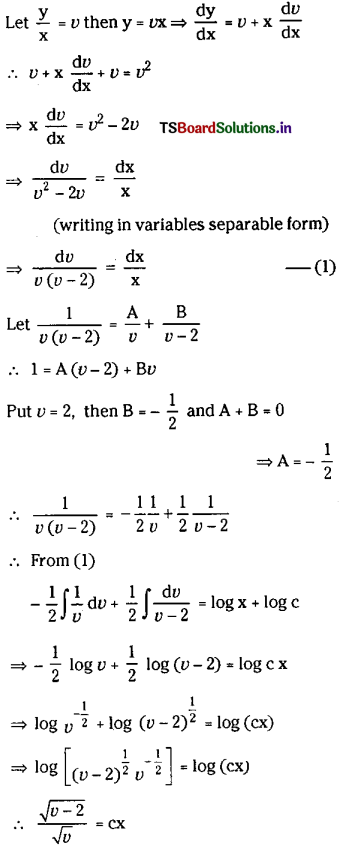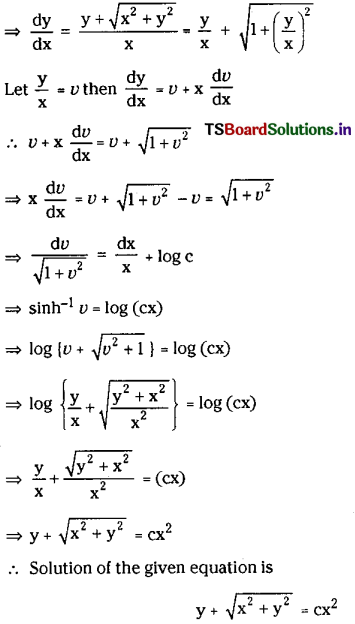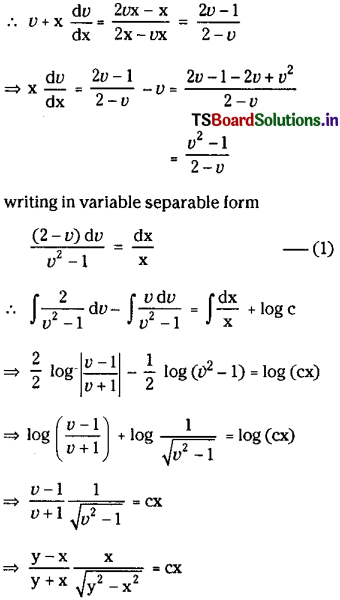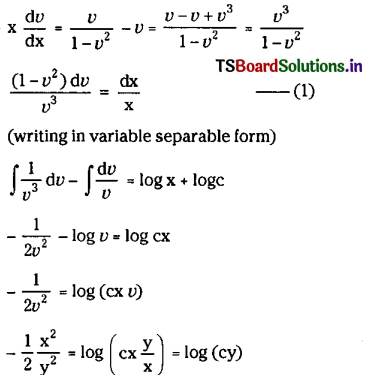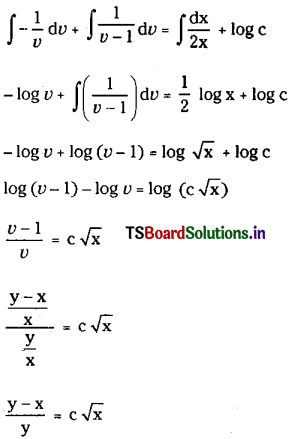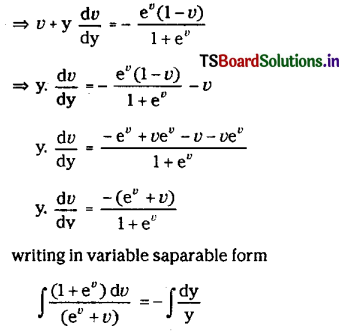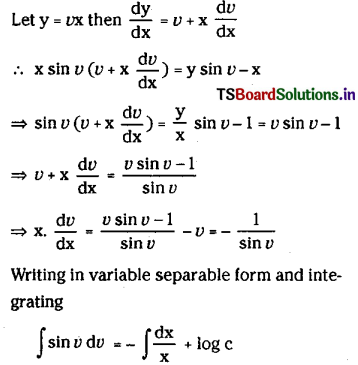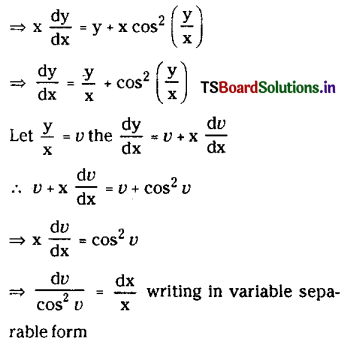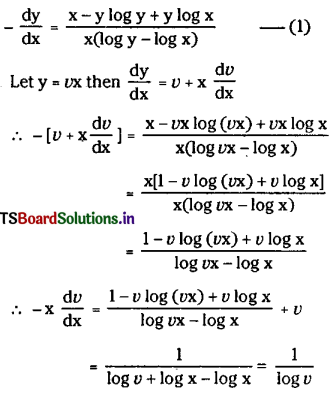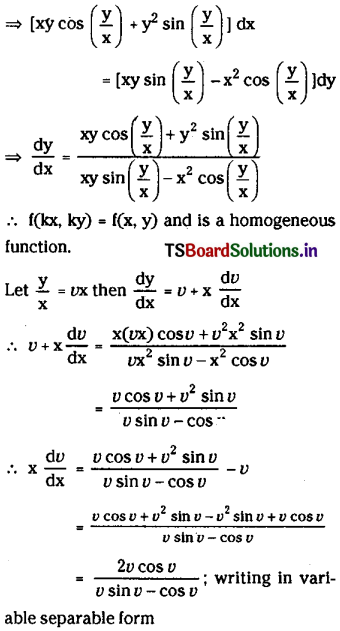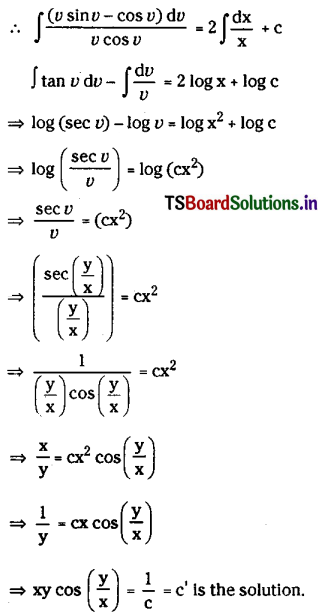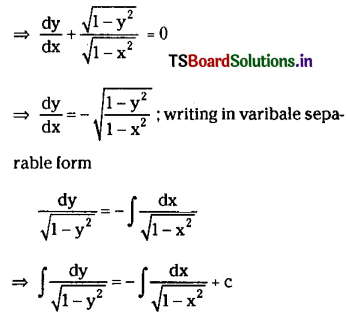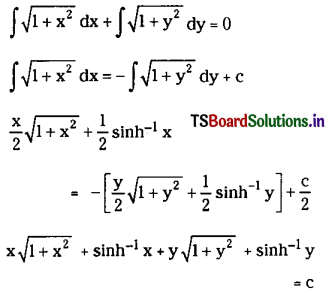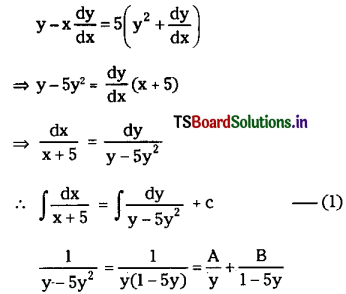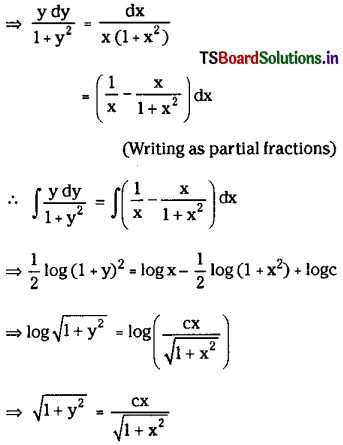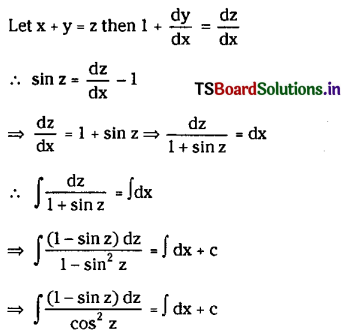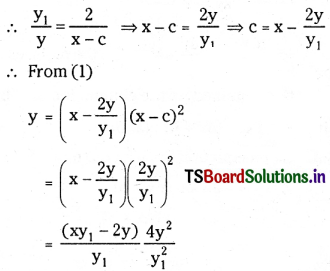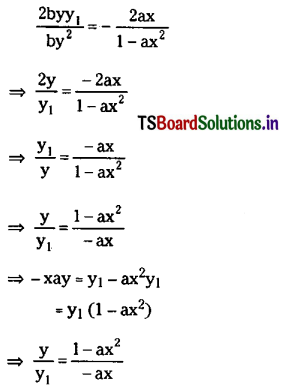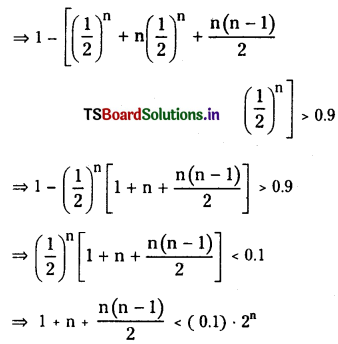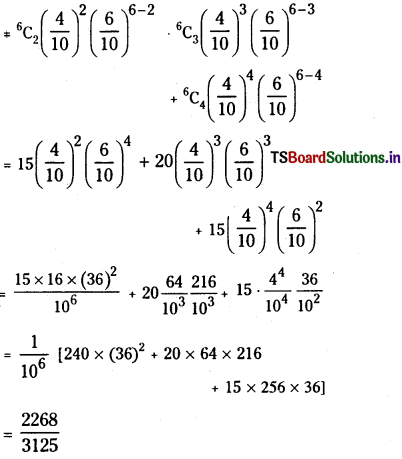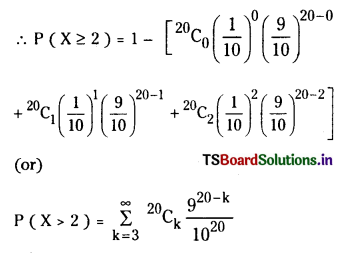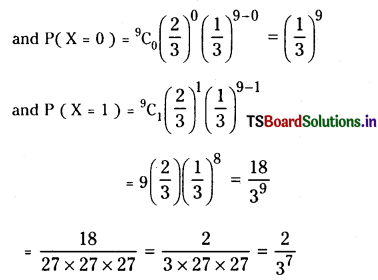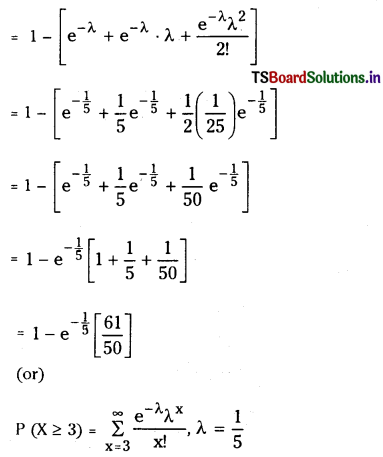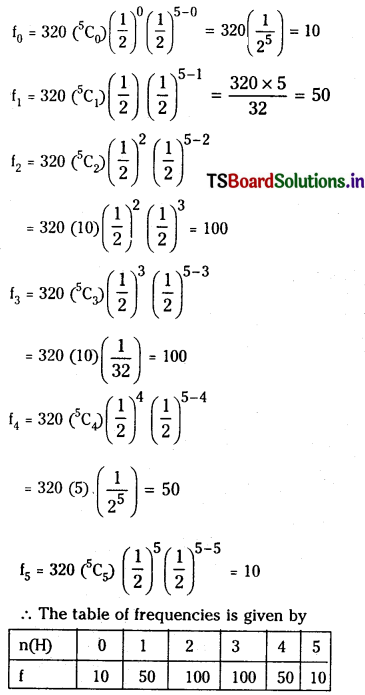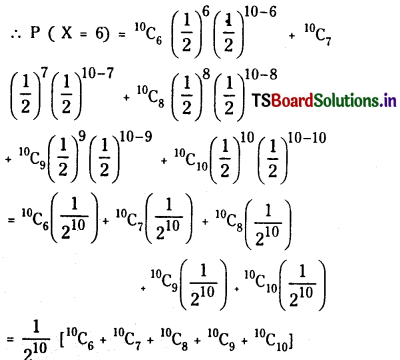Students must practice these TS Inter 2nd Year Maths 2A Important Questions Chapter 5 Permutations and Combinations Important Questions to help strengthen their preparations for exams.
TS Inter 2nd Year Maths 2A Permutations and Combinations Important Questions Important Questions
Question 1.
If nP4= 1680, find n.
Solution:
We know that ‘P4 is the product of 4 consecutive integers of which n is the largest.
That is nP4 = n(n – 1) (n – 2) (n – 3) and 1680 = 8 x 7 x 6 x 5
on comparing the largest integers, we get n = 8.

Question 2.
If 12Pr = 1320, find r.
Solution:
1320 = 12 x 11 x 10= 12P3 .
Thus r = 3.
Question 3.
If (n+1)P5 : nP5 = 3 : 2, find n.
Solution:
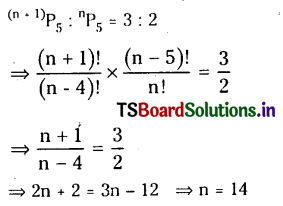
Question 4.
If 56(r+6) : 54P(r+3) = 30800 : I, find r.
Solution:
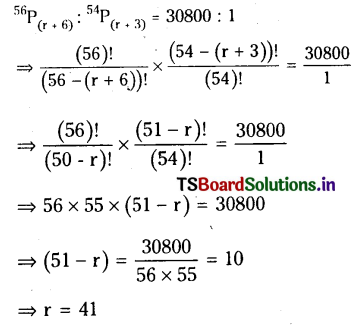
Question 5.
In how many ways 9 mathematics papers can be arranged so that the best and the worst
(i) may come together
(ii) may not come together?
Solution:
(i) lf the best and worst papers are treated as one unit, then we have 9 – 2 + 1 = 7+ 1+ 8 papers.
Now these can be arranged in (7+1) ! ways and the best and worst papers between themselves can be permuted in 2 ! ways. Therefore the number of arrangements in which best and worst papers come together is 8 ! 2 !

(ii) Total number of ways of arranging 9 mathematics papers is 9! . The best and worst papers come together in 8! 2! ways. Therefore the number of ways they may not come together is 9! – 8! 2! = 8!(9-2)= 8 ! × 7.
Question 6.
Find the number of ways of arranging 6 boys and 6 girls In a row. In how many of these arrangements
(i) all the girls are together
(ii) no two girls are together
(iii) boys and girls come alternately?
Solution:
6 boys + 6 girls = 12 persons. They can be arranged in a row in (12) ! ways.
(i) Treat the 6 girls as one unit. Then we have 6 boys + 1 unit of girls. They can be arranged in 7! ways. Now, the 6 girls among themselves can be permuted in 6! ways. Hence, by the fundamental principle, the number of arrangements in which all 6 girls are together 7! x 6!.
(ii) First we arrange 6 boys in a row in 6! ways. The girls can be arranged in the 7 gaps between the boys. These gaps are shown below by the letter X.
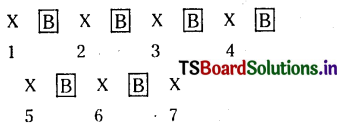
Now, the girls can be arranged In these 7 gaps in 7P6 ways. Hence, by the fundamental principle, the number of
arrangements in which no two girls come together is 6! x 7P6 = 6! x 7! = 7 x 6! x 6!.
(iii) Let us take 12 places. The row may begin with either a boy or a girl. That is, 2 ways. If it begins with a boy, then all odd places (1, 3, 5, 7, 9, Ii) will be occupied by boys and the even places (2, 4, 6, 8. 10, 12) by girls. The 6 boys can be arranged in the 6 odd places in 6! ways and the 6 girls can be arranged in the 6 even places in 6! ways. Thus the number of arrangements in which boys and girls come alternately is 2 x 6! x 6!.
Note: In the above, one may think that ques tions (ii) and (iii) are same. But they are not (as evident Irom the answers). In Question (ii), after arranging 6 boys, we found 7 gaps and 6 girls are arranged in these 7 gaps. Hence one place remains vacant. It can be any one of the 7 gaps. But in Question (iii), the vacant place should either be at the beginning or at the ending but not in between. Thus, only 2 choices for the vacant place.

Question 7.
Find the number of 4 letter words that can he formed using the letters of the word
MIRACLE. How many of them
(i) begin with an vowel
(ii) begin and end with vowels
(iii) end with a consonant?
Solution:
The word MIRACLE has 7 letters. Hence the number of 4 letter worlds that can be formed using these letters is
7P4 = 7 x 6 x 5 x 4 = 840. Let us take 4 blanks.

(i) We can fill the first place with one of the 3 vowels (1, A, E) 3P1 days. Now, the remaining 3 places can be filled using the remaining 6 letters in 6P3 120 ways. Thus the number of 4 letter words that begin with an vowel is 3 x 120 360.
(ii) Fill the first and last places with 2 vowels in 6P2 6 ways. The remaining 2 places can be filled with the remaining 5 letters in 5P2 = 20 ways. Thus the number of 4 letter words that begin and end with vowels is 6 x 20= 120.
(iii) We can fill the last place with one of the 4 consonants (M, R, C, L) in 4P1 = ways. The remaining 3 places can be filled with the letters in 6P3 ways. Thus the number of 4 letter words that end with an vowel is 4 x 6P3 = 4 x 120 = 480.
Question 8.
Find the number of ways of permuting the letters of the word PICTURE so that
(i) all vowels come together
(ii) no two vowels come together.
(iii) the relative positions of vowels and consonants are not disturbed.
Solution:
The word PICTURE has 3 vowels (I, U, E) and 4 consonants (P, C, T, R).
(i) Treat the 3 vowels as one unit. Then we can arrange 4 consonants + 1 unit of vowels in 5! ways. Now the 3 vowels among themselves can be permuted in 3! ways. Hence the number of permutations in which the 3 vowels come together is 5! x 3! 720.

(ii) First arrange the 4 consonants in 4! ways. Then in between the vowels, in the beginning and in the ending, there are 5 gaps as shown below by the letter X.

In these 5 places we can arrange the 3 vowels 5P3 ways. Thus the number of words in which rio two vowels come
to gether is 4! x 5P3 = 24 x 60 = 1440.
(iii)The three vowels can be arranged in thier relative positions in 3’ ways and the 4 consonants can be arranged in their relative positions in 4 ways. The required number of arrangements is 3! . 4! = 144.
Note: In the above problem, from (i) we get that the number of permutations in which the vowels do not come together is = Total number of permutations – number of permutations in which 3 vowels come together.
7! – 5!. 3! = 5040 – 720 = 4320.
But the number of permutations in which no two vowels come together is only 1440. In the remaining 2880 permutations, two vowels come together and third appears away from these.
Question 9.
If the letters of the word PRISON are permuted in all possible ways and the words thus formed are arranged In dictionary order, find the rank of the word PRISON.
Solution:
The letters of the given word in dictionary order is
N O P R S
In the dictionary order, first we write all words that begin with I. If we fill the first place with I, the remaining 5 places can be filled with the remaining 5 letters in 5! ways. That is, there are 5! words that begin with I. Proceeding like this, after writing all words that begin with I, N, O, we have to write the words begin with P. Among them first come the words with first two letters P, I. As above there are 4! such words. On proceeding like this, we get
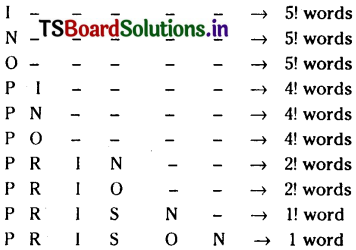
Hence the rank of the word PRISON Is
3×5! + 3×4! + 2×2! + 1! + 1
= 360+72+4+1 + 1= 438
Question 10.
Find the number of 4-digit numbers that can be formed using the digits 2, 3, 5, 6, 8 (without repetition). How many of them are divisible by
(i) 2 (ii) 3 (iii) 4 (iv) 5 (v)25
Solution:
The number of 4 digit numbers that can be formed using the 5 digit 2, 3, 5, 6, 8 is = 120.
(i) Divisible by 2: For a number to be divisible by 2, the units place should be filled with an even digit. This can be done in 3 ways (2 or 6 or 8).

Now, the remaining 3 places can be filled with the remaining 4 digits in = 24 ways. Hence, the number of 4-digit numbers divisible by 2 is 3 x 24 = 72.
(ii) Divisible by 3: A number is divisible by 3 ii the sum of the digits in it is a multiple of 3. Since the sum of the given 5 digits is 24, we have to leave either 3 or 6 and use the digits 2, 5, 6, 8 or 2, 3, 5, 8. In each cae, we can permute them In 4! ways. Thus the number of 4 – digit numbers divisible by 3 is 2 x 4! = 48.

(iii) Divisible by 4 : A number is divisible by 4 if the number formed by the digit in the last two places (tens and units places) is a multiple of 4.

Thus we fill the last two places (as shown in the figure) with one of 28,32,36,52,56,68 That is done in 6 ways. After filling the last two places, we can fill the remaining two places with the remaining 3 digits in 3P2 ways.
Thus, the number of 4 – digit numbers divisible by 4 is 6 ×6=36.
(v) Divisible by 5 : After filling the units place with 5 (one way), the remaining 3 places can be filled with the remaining 4 digits in 4P3 = 24 ways. Hence the number of 4 digit numbers divisible by 5 is 24.
(vi) Divisible by 25 : Here also we have to fill. the last two places (that is, units and tens place) with 25 (one way) as shown below.

Now the remaining 2 places can be filled with the remaining 3 digits in 3P2 = 6 ways. Hence the number of 4 digit numbers divisible by 25 is 6.
Question 11.
Find the sum of all 4-digit numbers that can be fonned using the digits 1, 3, 5, 7, 9.
Solution:
We know that the number of 4-digit numbers that can be formed using the given 5P4 digits is = 120. Now we find their sum. We first find the sum of the digits in the unit place of all these 120 numbers. If we fill the units place with 1 as shown below

then the remaining 3 places can be filled with the remaining 4 digits in 4P3 ways. This means, the number of 4 digit numbers having 1 in units place is 4P3 . Similarly, each of the digits 3, 5, 7, 9 appear 24 times in units place. By adding aB these digits we get the sum of the digits in units place of all 120 numbers as

Similarly, we get the sum of the digits in tens place as 4P3 x 25.
Since it is in 10’s place, its value is = 4P3 x 25 x 10.
Similarly, the value of the sum of the digits in 100s place and 1000s place are 4P3 x 25 x 100 and 4P3 x 25 x 1000
respectively. Hence the sum of the 4 digit numbers formed by using the digits 1, 3,5, 7, 9 is.
4P3 x 25 x 1+4P3 x 25 x 10 + 4P3 x 25 x 100
= 4P3 x 25 x 1000
= 4P3 x 25 x 1111 ……………………. (*)
= 24 x 25 x 1111 = 6,66,600
Note:
1. From (*) in the above example, we can derive that the sum of all r-digit numbers that can be formed using the given ‘n non-zero digits (1 ≤ r ≤ n ≤ 9) is
(n-1)P(r-1) x sum of the given digits x 111 …. 1 (r times)
2. In the above, if ‘0’ is one digit among the given n digits, then we get the sum of the r – digit numbers that can be formed using thegiven n digits (including ‘0’)
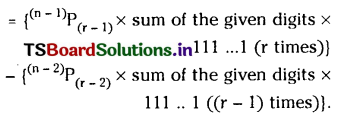

Question 12.
How many four digited numbers can be formed using the digits 1, 2, 5,7, 8, 9? How many of them begin with 9 and end with 2?
Solution:
The number of four digited numbers that can be formed using the given digits 1, 2, 5, 7, 8, 9 is 6P4 = 360. Now, the first place and last place can be filled with 9 and 2 in one way.
The remaining 2 places can be filled by the remaining 4 digits 1, 5, 7, 8. Therefore these two places can be filled in 4P2 ways. Hence, the required number of ways = 1 . 4P2 = 12.
Question 13.
Find the number of injections of a set A with 5 elements to a set B with 7 elements.
Solution:
The first element of A can be mapped to any one of the 7 elements in 7 ways. The second element of A can be mapped to any one of the remaining 6 elements in 6 ways. Proceeding like this we get the number of injections from
A to B as 7P5 = 2520.
Note : If a set A has m elements and set B has n elements, then the number of injections from A into B is nPm if m≤n and 0 if m > n.
Question 14.
Find the number of ways in which 4 letters can be put in 4 addressed envelopes so that no letter goes into the envelope meant for it.
Solution:
Required number of ways is
\(4 !\left(\frac{1}{2 !}-\frac{1}{3 !}+\frac{1}{4 !}\right)=12-4+1=9\)
Note : If there are n things is a row, a permutation of these n things such that none of them occupies its original position is called a derangement of n things. The number of derangements of n distinct things is
\(\mathrm{n} !\left(\frac{1}{2 !}-\frac{1}{3 !}+\frac{1}{4 !}-\frac{1}{5 !}+\ldots . .+(-1)^{\mathrm{n}} \frac{1}{\mathrm{n} !}\right)=9\)

Question 15.
Find the number of 5-letter words that can be formed using the letters of the word ‘ MIXTURE which begin with an vowel when repetitions are allowed.
Solution:
We have to fill up 5 blanks using the letters of the word MIXTURE having 7 letters among which there are 3 vowels. Fill the first place with one of the vowels (I or U or E) in 3 ways as shown below.

Each of the remaining 4 places can be filled in 7 ways (since we can use all 7 letters each time). Thus the number of 5 letter words is 3 x 7 x 7 x 7 x 7 3 x 74.
Question 16.
Find the number of functions from a set A with in elements to a set B with n elements.
Solution:
Let A {a1,a2, ……………….. am} and B {b1, b2,…., bn} To define the image of a1 we have n choices (any element of B). Then we can define the image of a2 again in n ways (since a1, a2 can have same image). Thus we can define the image of each of the m elements in n ways. Therefore the number of functions from A to B is n x n x …………x n (m times) = nm.
Question 17.
Find the number of surjections from a set A with n elements to a set B with 2 elements when n > i.
Solution:
Let A {a1,a2, ……………….. an}and B = {x, y}. From the above problem. the total number of functions from A onto B is 2. For a function to be a surjection its range should contain both x, y. Observe that the number of functions which are not surjections that is, the functions which contain x or y alone in the range is 2. Hence the number of surjections from A to B is 2n – 2.
Note: In the above problem. even if B has more than 2 elements also we can derive a formula to find the number of surjections from A to B. But this result is beyond the scope of this book and hence it is not included here.
Question 18.
Find the number of 4-digit numbers that can be formed using the digits 1, 2, 3, 4, 5, 6 that ate divisible by
(i) 2
(ii) 3 when repetition is allowed.
Solution:
(i) Numbers divisible by 2:
Take 4 blanks. For a number to be divisible by 2, the units place should be filled with an even digit. This can be done in 3
ways (2 or 4 or 6).

Now, each of the remaining 3 places can be filled in 6 ways. Hence the number of 4 digit numbers that are divisible by 2 is 3 x 63 = 3 x 216 = 648.

(ii) Numbers divisible by 3:
Fill the first 3 places with the given 6 digits in 63 ways.

Now, after filling up the first 3 places with three digits, if we fill up the units place in 6 ways, we get 6 consecutive positive integers. Out of any six consecutive integers exactly two are divisible by 3. Hence the units place can be filled in 2 ways. hence the number of 4 digit numbers divisible by 3 is 2 x 216 = 432.
Question 19.
Find the number of 5- letter words that can be formed using the letters of the word Explain that begin and end with a vowel when repetitions are allowed.
Solution:
We can fill the first and last places with vowels each in 3 ways (E or A or I).

Now each of the remaining 3 places can be filled in 7 ways (using any letter of given 7 letters). Hence the number of 5 letter words which begin and end with vowels is 32 x 73 = 9 x 343 = 3087.
Question 20.
Find the number of ways of arranging 8 men and 4 women around a circular table. In how many of them
(i) all the women come together
(ii) no two women come together.
Solution:
Total number of persons = 12 (8 men + 4 women)
Therefore, the number of circular permutations is (1 1)
(i) Treat the 4 women as single unit. Then we have 8 men. 1 unit of women = 9 entities. They can be arranged around a circular table In 8! ways. Now the 4 women among themselves can be arranged in 4! ways. Hence by the Fundamental principle, the required number of arrangements is 8! x 4!.’
(ii)
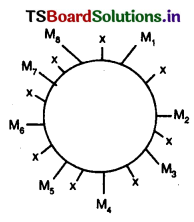
First we arrange 8 men around the circular table in 7! ways. There are 8 places In between them as shown In figure by the symbol x. (one place in between any two consecutive men).
Now we can arrange the 4 women in these 8 places in 8P4 ways. Thus, the number of circular permutations in which no
two women come together is 7! x 8P4.
Question 21.
Find the number of ways of seating 5 indians, 4 Americans and 3 Russians at a round table so that
i) all Indians sit together
ii) no two Russians sit together
iii) persons of same nationality sit together.
Solution:
(i) Treat the 5 indians as one unit. Then we have 4 Americans + 3 Russians + 1 unit of Indians = 8 entities.
They can be arranged at a round table in (8 – 1)! = 7! ways. Now, the 5 Indians among themselves can be arranged in 5! ways. Hence, the required number of arrangements is 7! x 5!.

(ii) First we arrange the 5 Indians + 4 Americans around the table in (9 – 1)! = 8! ways. Now, there are 9 gaps in between these 9 persons (one gap between any two consecutive persons). The 3 Russians can be arranged in these 9 gaps in 9P3 ways. Hence, the required number of arrangments is 8! x 9P3.
(iii)Treat the 5 Indinas as one unit, the 4 Americans as one unit and the 3 Russians as one unit. These 3 units can be
arranged at round table in (3 – 1)! = 2! ways.
Now, the 5 Indians among themselves can be permuted in 5! ways. Similarly, the 4 Americans in 4! ways and 3 Russians in 3! ways. Hence, the required number of arrangments is 2! x 5! x 4! x 3!.
Question 22.
Find the number of different chains that can be prepared using 7 different coloured beads.
Solution:
We know that the number of circular permutations of hanging type that can be formed using n things is \(\frac{1}{2}\) ((n -1)!). Hence the number of different ways of preparing the chains = \(\frac{1}{2}\{(7-1) !\}=\frac{6 !}{2}=360\)
Question 23.
Find the number of different ways of preparing a garland using 7 distinct red roses and 4 distinct yellow roses such that no two yellow roses come together.
Solution:
First we arrange 7 red roses in a circular form (garland form) in (7 – 1)! = 6! ways. Now, there are 7 gaps in between the red roses and we can arrange the 4 yellow roses in these 7 gaps 7P4 ways. Thus the total number of circular permutations is 6! x 7P4. But, this being the case of garlands, clock wise and anti-clock-wise arrangements look a like. Hence the required number of ways is \(\frac{1}{2}\) (6! x 7P4)
Question 24.
Find the number of ways of arranging the letters of the word SINGING so that
i) they begin and end with l
ii) the two G’s come together
iii) relative positions of vowels and consonants are not disturbed.
Solution:
(i) First we fill the first and last places with
I’s in \(\frac{2 !}{2 !}\) = 1 way as shown below

Now, we fill the remaining 5 places with the remaining 5 letters S, N, G, N, G in
\(\frac{5 !}{2 ! 2 !}\) = 30 ways.
Hence, the number of required permutations is 30.
(ii) Treat the two G’s as one unit. Then we have 6 letters In which there are 2I’s and 2N’s.
Hence they can be arranged in
\(\frac{5 !}{2 ! 2 !}\) = 180 ways
Now, the two G’s among themselves can be arranged in \(\frac{2 !}{2 !}\) = 1 way. Hence the number of required permutations is 180.
(iii) In the word SINGING, there are 2 vowels which are alike i.e., 1, and there are 5 consonants of which 2Ns and 2Gs are
alike and one S is different.
C V C C V C C
The two vowels can be interchanged among themselves in \(\frac{2 !}{2 !}\) = 1 way. Now, the 5 consonants can be arranged in the remaining 5 places in \(\frac{5 !}{2 ! 2 !}\) = 30 ways.
∴ Number of required arrangements = 1 x 30 = 30.

Question 25.
Find the number of ways of arranging the letters of the word a4b3c5 in its expanded form.
Solution:
The expanded form of a4b3c5 is
aaaa bbb ccccc
This word has 12 letters in which there are 4 a’s, 4 b’s and 5c’s. By Theorem 5.5.2, they can be arranged in ways.
\(\frac{12 !}{4 ! 3 ! 5 !}\) ways.
Question 26.
Find the number of 5 – digit numbers that can be formed using the digit 1, 1, 2, 2, 3. How many of them are even?
Solution:
In the given 5 digits, there are two l’s and two 2’s. Hence they can be arranged in 5!
\(\frac{5 !}{2 ! 2 !}\) = 30 ways.
Now, to find even numbers fill the units place by 2. Now the remaining 4 places can be filled using the remaining digits 1, 1, 2, 3, in
\(\frac{4 !}{2 !}\) = 12 ways.
Thus the number of 5 – digit even numbers that can be formed using the digits 1, 1, 2, 2, 3 is 12.
Question 27.
There are 4 copies (alike) each of 3 different books. Find the number of ways of arranging these 12 books in a shelf in a single row.
Solution:
We have 12 books in which 4 books are alike of one kind, 4 books are alike of second kind and 4 books are alike of third kind. Hence, by Therorem 5.5.2., they can be arranged in a shelf in a row in \(\frac{12 !}{4 ! 4 ! 4 !}\) ways.
In problem 9 of solved problems 5.2.12, we have calculated the rank of the word PRISION. In the following problem we find the rank of a word when it contains repreated letters.
Question 28.
If the letters of the word EAMCET are permuted in ail possible ways and If the words thus formed are arranged in the dictionary order, find the rank of the word EAMCET.
Solution:
The dictionary order of the letters of given word is A C E E M T
In the dictionary order the words which begin with the letter A come first. If we fill the first place with A, remaining 5 letters can be arranged \(\frac{5 !}{2 !}\) ways (since there are two Es).
On proceeding like this (as in problem 9 or 5.2.12) we get
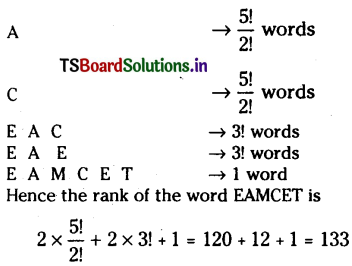
Question 29.
Find the number of ways of selecting 4 boys and 3 girls from a group of 8 boys and 5 girls.
Solution:
4 boys can be selected from the given 8 boys in 5C4 ways and 3 girls can be selected from the given 5 girls in 5C3 ways. Hence, by the Fundamental principle, the number of required selections is
8C4 x 5C3 = 70 x 10 = 700
Question 30.
Find the number of ways of selecting
4 English, 3 Telugu and 2 Hindi books out of 7 English, 6 Telugu and 5 Hindi books.
Solution:
The number of ways of selecting
4 English books out of 7 books = 7C4
3 Telugu books out of 6 books = 6C3
2 HIndi books out of 5 books = 5C2
Hence, the number of required ways
7C4 x 6C3 x 5C2 = 35 x 20 x 10 = 7000
Question 31.
Find the number of ways of forming a committee of 4 members out of 6 boys and 4 girls such that there is least one girl in the committee.
Solution:
The number of ways of forming a committee of 4 members out of 10 members (6 boys + 4 girls) is 10C4 . Out of these, the number of ways of forming the committee having no girl is 6C4 (we select all 4 members from boys). Therefore, the number of ways of forming the committees having atleast one girl is 10C4– 6C4 = 210 – 15 = 195.

Question 32.
Find the number of ways of selecting 11 member cricket team from 7 batsmen, 6 bowlers and 2 wicket-keepers so taht the team contaIns 2 wicket-keepers and atleast 4 bowlers.
Solution:
The required cricket team can have the following compositions.

Therefore, the number of ways of selecting the required cricket team = 315 + 210 + 35 = 560
Question 33.
If a set of rn’ parallel lines intersect another set of ‘n’ parallel lines (not parallel to the lines in the first set), then find the number of parallelograms formed In this lattice structure.
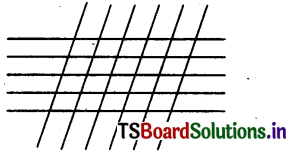
Solution:
Whenever we select 2 lines from the first set of m lines ad 2 lines from the second set of n lines, one parallelogram is formed as shown in the figure. Thus, the number of parallelogram formed mC2 x mC2
Question 34.
There are rn’ points in a plane out of which ‘p’ points are colinear and no three of the points are collinear unless all the three are from these p points. Find the number of different
(i) straight lines passing through pairs of distinct points.
(ii) triangles formed by joining these points (by line segments).
Solution:
(i) From the given ‘m’ points, by drawing straight lines passing through 2 distinct points at a time, we are supposed to get mC2 number of lines. But, since p’ out of these ‘m’ points are coil mear, by forming lines passing through these p points 2 at a time we get only one line instead of getting pC2. Therefore, the number of different lines as required is
mC2 – pC2 + 1.
(ii) From the given m points, by joining 3 at a time, we are supposed to get mC3 number of triangles. Since p points out of these m point are collinear, by joining these p points 3 at a time we do not get any triangle (we get only a Line) when we are supposed to get number of triangles. Hence the number of triangles formed by joining the given m points is
mC3 – pC3
Note : The number of diagonals in an n-sided polygon = \({ }^n C_2-n=\frac{n(n-3)}{2}\)
Question 35.
A teacher wants to take 10 students to a park. He can take exactly 3 students at a time and will not take the same group of 3 students more than once. Find the number of times (i) each student can go to the park (ii) the teacher can go to the part.
Solution:
i) To find the number of times a student can go to the park, we have to select 2 more students from the remaining 9
students. This can be done in pC2 ways. Hence, each student can go to park = 36 times.
ii) The number of times the teacher can go to park = The number of different ways of selecting 3 students out of 10
= 10C3 = 120

Question 36.
A double decker minibus has 8 seats in the lower deck and 10 seats On the upper deck. Find the number of ways of arranging 18 persons in the bus If 3 children want to go to the upper deck and 4 old people can not go to the upper deck.
Solution:
Allowing 3 children, to the upper deck and 4 old people to the lower deck we are left with li people and 11 seats (7 in the upper deck and 4 in the lower deck). We can select 7 people for the upper deck out of the 11 people in 11C7 ways. The remaining 4 persons go to lower deck. Now we can arrange 10 persons (3 children and 7 others) in the upper deck and 8 persons (4 old people and 4 others) in the lower deck in 10! and 8! ways respectively. Hence, the required number arrangements = 11C7 x 10! 8!
Question 37.
Prove that

Solution:
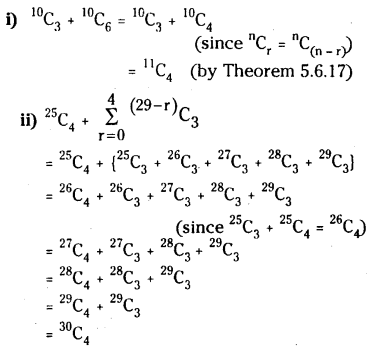
Question 38.
(i) If \({ }^{12} C_{s+1)}={ }^{12} C_{(2 s-5)}\), find s
(ii) If \({ }^n C_{21}={ }^n C_{27} \text {, find }{ }^{50} C_n\)
Solution:
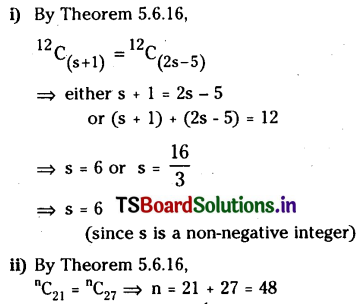

Question 39.
14 persons are seated at a round table. Find the number of ways of selecting two persons out of them who are not seated adjacent to each other.
Solution:
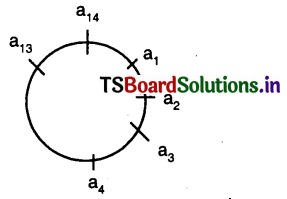
Let the seating arrangement of given 14 persons at the round table be as shown in figure.
Number of ways of selecting 2 persons out of 14 persons 14C2 = 91.
In the above arrangement two persons sitting adjacent to each other can be selected in 14 ways
(they are a1, a2, a3, a13,a14, a15 a1).
Therefore, the required number of ways = 91 – 14 = 77
![]()
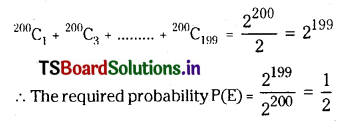
![]()

![]()
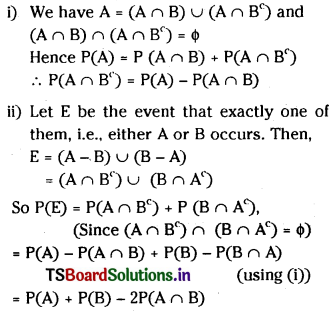
![]()
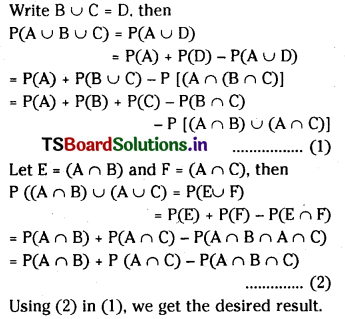
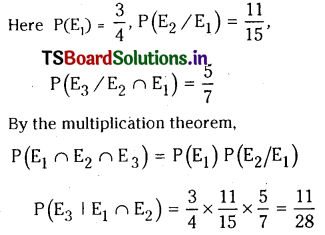
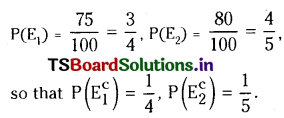
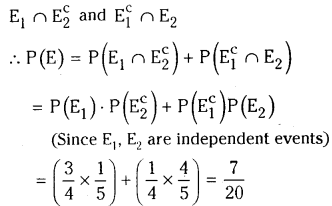
![]()

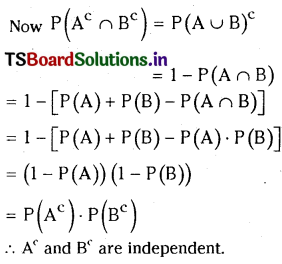
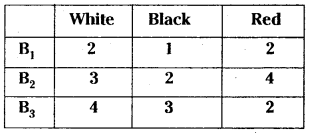
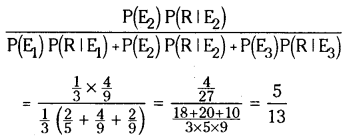
![]()
